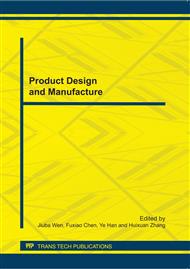p.94
p.102
p.108
p.114
p.119
p.129
p.134
p.138
p.144
The Establishment of a Prediction Model for Surface Roughness in Ultrasonic-Assisted Turning
Abstract:
During experimentation, traditional Taguchi analysis often uses L18 or L27 orthogonal array, with a considerable number of test sequences for Run 18 or Run 27. Both are time-consuming and expensive. A progressive Taguchi-neural network model is proposed in this study, which combines the Taguchi method with a neural network construction, and can construct a prediction model for surface roughness in ultrasonic-assisted turning. According to the results, the Stage-1 initial-network, due to its limited number of network training examples, generates good predictive ability results for regions near Taguchi factor level points. For learning and training examples from regions farther out, prediction results are increasingly unreliable. Comparably, the Stage-3 precision-network generates the more reliable predictions for global regions.
Info:
Periodical:
Pages:
119-125
Citation:
Online since:
October 2011
Authors:
Price:
Сopyright:
© 2012 Trans Tech Publications Ltd. All Rights Reserved
Share:
Citation:


